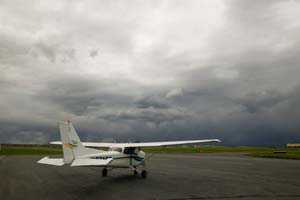 Did you know that more than 70 percent of VFR into IMC accidents are fatal? This remains a lethal aspect of flight, and the accidents involve pilots of all certificate and experience levels. In 2010, 41 percent of VFR into IMC accidents had at least one instrument-rated pilot on board.
Did you know that more than 70 percent of VFR into IMC accidents are fatal? This remains a lethal aspect of flight, and the accidents involve pilots of all certificate and experience levels. In 2010, 41 percent of VFR into IMC accidents had at least one instrument-rated pilot on board.
Getting caught off guard flying VFR into IMC presents an extremely dangerous situation that can quickly lead to loss of aircraft control caused by spatial disorientation. Flight instructors know this but might find it difficult to transfer that fact into a teachable lesson plan. Enter the Air Safety Institute’s VFR into IMC syllabus. The curriculum is recommended for use by flying clubs, flight schools, and CFIs to teach pilots how to recognize and understand conditions that can lead to inadvertent VFR flight into IMC, and how to safely escape IMC should visual references be lost. The 12-page booklet includes ground and flight lesson plans, and provides guidance on objectives, discussion points, and completion standards for each lesson. Download the syllabus and the “IMC Escape Procedures” checklist and share with your fellow club members. The checklist on the last page of the booklet is in a printer-friendly format and would be a good place to begin a safety meeting with your club on this topic.
ASI has put all of its VFR into IMC resources on one web page for easy reference:
As we enter the busy spring and summer flying season, take time to discuss this topic with your club—considering the high fatality rate of VFR into IMC accidents, the more we talk about it and how to avoid such conditions, the more lives can be saved.
Many ASI products are eligible for Wings credit and AOPA Accident Forgiveness. In addition, you may download certificates of completion from your ASI Transcript.
The Air Safety Institute is a division of the non-profit AOPA Foundation. Funding for ASI safety programs comes from the generosity of pilots like you.